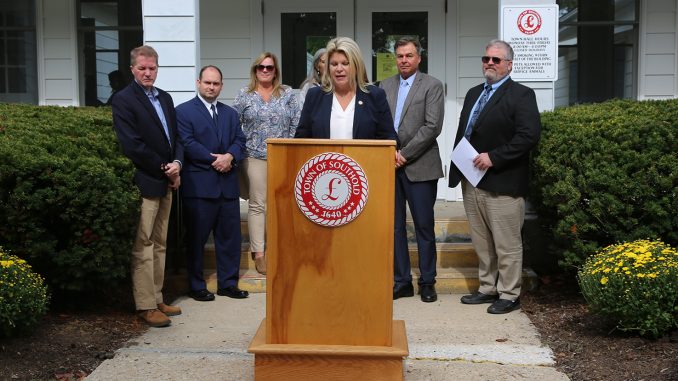
State and local officials have condemned a federal court decision to uphold a 2020 decision that allows Connecticut to deposit dredge materials into the eastern Long Island Sound.
The federal decision, handed down in early September, affirmed the resolution to a lawsuit originally filed in 2017 over an EPA designation of an open water site in the eastern Long Island Sound for the disposal of materials dredged from rivers and harbors impacted by commerce and industry.
At a press conference Friday, politicians and environmental advocates urged the U.S. Environmental Protection Agency to rescind the dredge site designation, highlighting the area’s sensitive ecosystem. The dumped materials will undo millions of dollars invested in restoration and harm the local economy by impacting adjacent fisheries and the tourism industry, stakeholders said.
“Millions of dollars have been invested by states, local governments and federal agencies in efforts to restore the habitats and water quality of the Long Island Sound, and by some metrics, we’re making progress. In others, we’re falling further and further behind,” said Assemblywoman Jodi Giglio (R-Baiting Hollow). “The last thing we need is to undo the hard work of so many environmentalists, agency staff and civic leaders — both in Connecticut and New York — with an ill-devised plan.”
Ms. Giglio pointed out that the Long Island Sound Study has prioritized areas of the sound around Fishers Island for conservation due to “highly sensitive eelgrass beds,” which have seen a more than 90% decline across Long Island over the past century, and the state has designated the waters “as an area of Significant Coastal Fish and Wildlife Habitat.”
There are only 2,000 acres of eelgrass left in Long Island Sound and the eelgrass meadows off Fishers Island make up a quarter of the remaining eelgrass areas in the waterbody, the North Fork Environmental Council said in a statement. NFEC representative Margaret de Cruz highlighted the ecological significance of the plant as food for marine life, a way to filter excess nutrients from water, and its role in maintaining shorelines.

“It seems like in 2022, there would be more of a science-based decision,” added Suffolk County Legislator Al Krupski (D-Cutchogue), urging the EPA to “come up with an acceptable upland proposal.”
“If Connecticut wants to improve their harbors for navigation and safety or whatever, that’s fine. But do it in a responsible way, and not impact an estuary that’s really significant environmentally and economically,” he said.
The EPA has two other dumping sites in the western and central sound that it had initially planned to close but now intends to keep open for the next 25 years, Ms. Giglio said, questioning why they’re remaining open if the EPA doesn’t plan to “make full use of them.”

“Fine contaminants will be directly deposited onto the shores of Fishers Island and will have a detrimental effect on what is arguably New York State’s last bastion of healthy thriving seagrass beds,” Ms. Giglio said, calling the eastern sound the “most pristine area” of the water body. “I fear this site will be another sad legacy we leave the next generation to clean up if we move forward with the proposal to use this as a dredged deposit site.”
Southold Supervisor Scott Russell said the town is evaluating its legal options, and “will take every and any action possible to undo this.”
“We are urging the EPA to withdraw their decision; to go back and do a more thorough environmental impact statement, which we found so faulty, careless and superficial in the beginning; to reverse their decision in the effort to help us continue to restore the Long Island Sound,” he said. “It is not just an environmental issue. It’s an economic issue. It will destroy fisheries, it will have negative impacts on our commercial fishing operations, it will have impacts on our tourism industry. And it will have impacts on everybody that enjoys the Long Island Sound, whether that’s to earn a livelihood or for recreational purposes.”

Be the first to comment